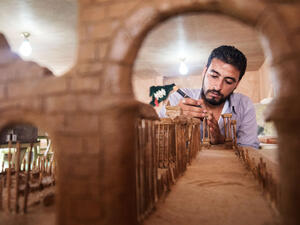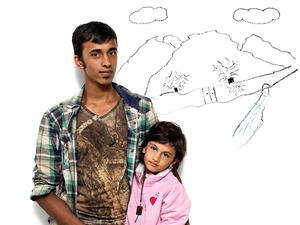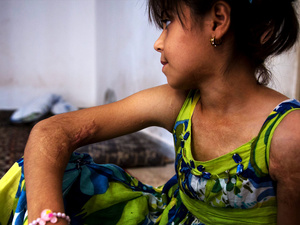Portrait of a refugee unveiled in Prague
Portrait of a refugee unveiled in Prague

Fragment of the poster of "Flight and Exile in Art" exhibition (opened at 19 July 2002 in Czech Republic).
PRAGUE, Czech Republic, July 19 (UNHCR) - Canvassing for refugees is a delicate art form, and nowhere is this clearer than at an exhibition that opened today in the Czech Republic under the auspices of President Vaclav Havel.
Held at the Imperial Stables in the Prague Castle, the "Flight and Exile in Art" exhibition draws comparisons between modern refugee crises and persecution and flight in ancient and contemporary times. Some 60 works of art are featured, juxtaposed with photographs from UNHCR's collection that show modern images of the themes embodied in the paintings.
"We hope to show the historical and territorial universality of exile through this exhibition," said Jean-Claude Concolato, UNHCR's Representative in the Czech Republic. "We want to show that the issue of flight and exile, which tends to be treated as an episode, is in fact a constant topic: In each century, the same ordeal has been experienced by various populations. UNHCR knows this element of history well and our mandate allows us to make it known to the public."
The exhibition showcases works by Picasso, Cranach, Poussin, Moore and many others borrowed from galleries and museums in the Czech Republic and abroad.
In a letter of support for the event, Czech President Havel wrote, "I am captivated by the concept of the exhibition, which uses a comparison of works of art from various periods and contemporary photographs to remind us of the sad lot of refugees - people who, as a result of ill-fated events, were forced to leave their homes and found themselves in flight or in exile."
To "evoke a feeling of movement", the exhibition has been set up like a train station, said UNHCR's Concolato. The journey starts with an introduction to the 1951 Refugee Convention, and offers refugee definitions through art works showing the expulsion from Eden. This is followed by seven platforms, each illustrating a different theme or era.
Visitors are first confronted with the concept and reality of persecution, then introduced to UNHCR's mandate and assistance to refugees in works by Vaillant and Poussin. They then trace the refugee's path from flight to return home through paintings of the holy family's experiences in Egypt.
One of the platforms is devoted to the work of Alfons Mucha, who portrays the archetypes and myths of flight as well as its historical dimension. Also showcased is the 1620 White Mountain battle (which put an end to Bohemia's independence for 300 years), the consequent flight of the inhabitants of the Czech lands, as well as the conflicts of the 19th century.
The exhibition concludes with "From Sarajevo to Sarajevo", an installation depicting European conflicts from World War I - triggered by the assassination of Archduke Franz Ferdinand of Austria in Sarajevo - to the Balkans crisis of the 1990s.
Explaining the exhibition's choice of media, Concolato said, "Paintings that are a few centuries old and depict themes that may seem dead to contemporary viewers have come to life again by the intervention of modern media: photographs."
He added, "The problem with photos and especially films is that they tend to present people as simple bodies, while painters usually perceive the dignity of people and reflect this in their works. This is why, by combining art works with photos, we give contemporary life to ancient paintings while the artists add dignity to the people portrayed on the photographs. In other words, we want to show that art is alive!"
Proceeds from "Flight and Exile in Art", which runs until September 15, will go to the Refugee Education Trust.









